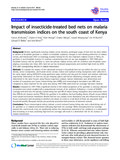| dc.description.abstract | Besides significantly reducing malaria vector densities, prolonged usage of bed nets has been linked to decline of
Anopheles gambiaes.s. relative to Anopheles arabiensis, changes in host feeding preference of malaria vectors, and behavioural shifts to exophagy (outdoor biting) for the two important malaria vectors in Africa,An.gambiae s.l. and
Anopheles funestus. In southern coastal Kenya, bed net use was negligible in 1997-1998 when Anopheles funestus
andAn. gambiaes.s. were the primary malaria vectors, with An. arabiensis and Anopheles merus playing a secondary role. Since 2001, bed net use has increased progressively and reached high levels by 2009-2010 with corresponding decline in malaria transmission.To evaluate the impact of the substantial increase in household bed net use within this area on vector
density, vector composition, and human-vector contact, indoor and outdoor resting mosquitoes were collected in
the same region during 2009-2010 using pyrethrum spray catches and clay pots for indoor and outdoor collections
respectively. Information on bed net use per sleeping spaces and factors influencing mosquito density were
determined in the same houses using Poisson regression analysis. Species distribution was determined, and number of mosquitoes per house, human-biting rates (HBR), and entomological inoculation rate (EIR) were compared to those reported for the same area during 1997-1998, when bed net coverage had been minimal. Compared to 1997-1998, a significant decline in the relative proportion of An. gambiaes.s. among collected mosquitoes was noted, coupled with a proportionate increase of An. arabiensis. Following > 5 years of 60-86% coverage with bed nets, the density, human biting rate and EIR of indoor resting mosquitoes were reduced by more than 92% for An. funestus and by 75% for An. gambiae s.l. In addition, the host feeding choice of both vectors shifted more toward non-human vertebrates. Besides bed net use, malaria vector abundance was also influenced by type of house construction and according to whether one sleeps on a bed or a mat (both of these are associated with household wealth). Mosquito density was positively associated with presence of domestic animals.These entomological indices indicate a much reduced human biting rate and a diminishing role of An. gambiae s.s. in malaria transmission following high bed net coverage. While increasing bed net coverage beyond the current levels may not significantly reduce the transmission potential of An. arabiensis, it is anticipated that increasing or at least sustaining high bed net coverage will result in a diminished role for An. funestus in malaria transmission. | en_US |

